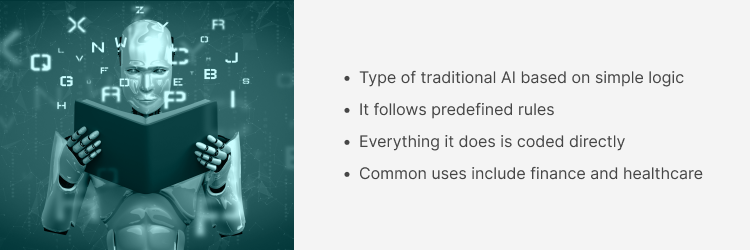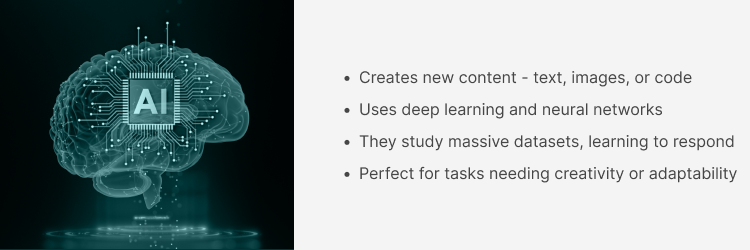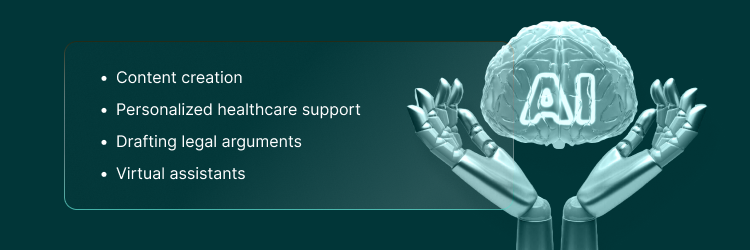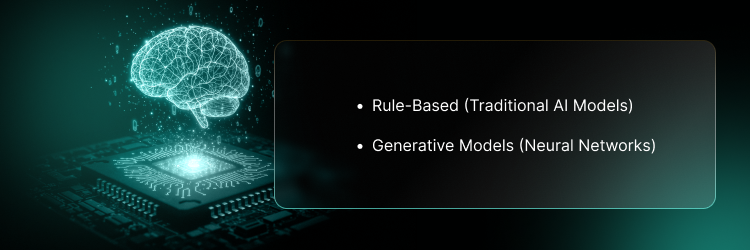
Artificial intelligence (AI) is everywhere—powering devices, tools, and businesses. Around 35% of companies already use AI, and about 77% of devices rely on it.
AI isn’t just one thing. It includes rule-based AI systems like email spam filters, and generative AI models like ChatGPT.
This article clearly explains the differences between rule-based AI vs generative AI. You’ll learn how these AI systems work, their pros and cons, and where each fits best. We’ll also explore what this means for AI development in the future.
What Is Rule-Based AI?

Rule-based AI is a type of traditional AI based on simple logic. It follows human-created, predefined rules to perform specific tasks.
This type of AI uses clear, if-then conditions. Everything it does is coded directly. It can’t learn or adjust behavior over time.
For example, a rule-based system might move emails to spam if they contain certain words like “earn money.” Or, it might instantly reply to customers asking about refunds.
The strength of rule-based AI is simplicity. It’s great for repetitive tasks, handling them quickly and accurately.
Common uses include finance and healthcare. These AI models can flag issues, make basic decisions, or sort data clearly and consistently.
What Is Generative AI?
Generative AI creates new content—text, images, or code. It learns patterns from existing data and uses deep learning and neural networks to generate original results.
Unlike traditional systems, generative AI models don’t follow fixed rules. Instead, they study massive datasets, learning to respond based on context and past examples.
A good example is ChatGPT. It doesn’t provide fixed answers from a database. Instead, it creates new, unique responses each time based on the input data it’s learned from.
This makes generative AI perfect for tasks needing creativity or adaptability—like content writing, image creation, or coding.
Key Differences Between Rule-Based AI and Generative AI
Here’s how rule-based AI vs generative AI compares:
- Learning: Rule-based AI can’t learn. Generative AI learns and improves continuously.
- Flexibility: Rule-based systems are rigid. Generative models adjust easily to new inputs.
- Adaptability: Generative AI understands context; rule-based systems don’t.
- Human involvement: Rule-based AI needs manual updates. Generative AI works independently once trained.
- Output: Rule-based AI gives predictable results. Generative AI produces varied, original outputs.
How Rule-Based AI Works in the Real World
Rule-based systems remain popular in many fields:
- Finance: Banks use fixed rules for fraud detection, automatically flagging unusual transactions.
- Healthcare: Diagnostic tools like MYCIN follow clear rules to diagnose infections quickly.
- Law: Automated systems fill out standard legal documents, flag compliance issues, and offer basic advice.
These traditional systems handle repetitive tasks reliably, speeding up standardized decisions.
Where Generative AI Excels
Generative AI excels in tasks needing creativity and adaptability:
- Content creation: Quickly writes articles, social media posts, or code snippets (e.g., ChatGPT, Jasper, GitHub Copilot).
- Personalized healthcare support: Suggests tailored treatments by analyzing patient data (AI4BetterHearts, Hippocratic AI).
- Drafting legal arguments: Generates case summaries and customized contracts (Harvey AI, Spellbook).
- Virtual assistants: Smarter customer service bots (Forethought, Ada).
Use of AI in Healthcare
AI supports healthcare differently based on its type:
Rule-Based Systems:
- Consistent analysis of patient data
- Alerts for common health conditions
- Reliable results for repetitive tasks
- Ensures standardized care
Generative AI Models:
- Advanced medical image analysis (MRI, X-ray)
- Personalized treatment suggestions
- Finds hidden patterns in large medical datasets
- Quickly adapts to changing patient needs
Legal Industry Applications
AI assists lawyers differently depending on task complexity:
Rule-Based Systems:
- Automates routine legal documents (NDAs, compliance forms)
- Handles repetitive tasks accurately
- Ensures consistency in structured tasks
Generative AI:
- Creates customized contracts
- Drafts legal arguments and case summaries
- Quickly adapts to changing laws
- Effective in sensitive legal contexts
Both approaches save time, improving productivity and accuracy.
Strengths and Limitations of Each Approach
Every AI system has pros and cons—let’s compare clearly:
Rule-Based AI
Strengths
- Reliable and consistent in what it does
- Gives you full control over outcomes
- Easy to explain how it works
- Great for automating specific, repetitive tasks
Limitations
- Can’t adapt or learn from new data
- Too rigid for handling complex situations
- Can’t anything outside its fixed logic
Generative AI
Strengths
- Handles creative and open-ended tasks well
- Adapts to different inputs and users
- Delivers personalized results
- Speeds up work by automating harder tasks
Limitations
- Needs vast dataset to work properly
- Results can vary and may lack consistency
- Brings up issues like data privacy and misinformation
- Expensive to build and maintain
AI Development and the Role of Data
Data shapes AI’s effectiveness. But the role data plays depends on the type of AI.
Rule-based AI works with structured, clearly organized data. It uses fixed logic and doesn’t adapt over time. If data fits specific rules, it performs reliably.
Generative AI learns differently, pulling insights from historical, unstructured data. It uses machine learning methods like supervised learning—learning by example to predict accurately.
Better data means smarter AI decisions.
Popular AI Models and Technologies
AI systems vary widely. Different models suit different tasks:
Rule-Based (Traditional AI Models)
- Expert systems: Used in medical tools like MYCIN
- Decision trees: Found in platforms like RapidMiner for decision-making and predictions
Generative Models (Neural Networks)
- Transformers: Power tools like ChatGPT, Google Bard
- Generative adversarial networks (GANs): Used in RunwayML and other platforms to create realistic images and videos
Related: Machine Learning vs Rule-Based Systems: Key Differences Explained
What Makes Generative AI So Powerful?
Generative AI learns from data and creates new content that feels natural.
It can:
- Spot patterns in unstructured data
- Generate human-like text or visuals
- Handle complex language tasks like summarizing, translating, or chatting in natural language
- It’s adaptability in perform diverse tasks in creative ways
Social and Business Applications
Rule-based systems and generative AI can help brands with the following:
Rule-Based AI
- Runs customer service scripts
- Automates compliance processes in finance and healthcare
Generative AI
- Creates social media posts
- Powers AI chatbots and virtual assistants
- Writes marketing copy that helps boost engagement and customer satisfaction
Related: AI in Marketing: How Artificial Intelligence Is Changing the Game
AI in Creative Fields
Generative models are reshaping how we approach art, music, and writing. You don’t need design experience anymore. Tools like Adobe Firefly turn text into stunning visuals instantly. This makes content creation accessible—even if you’ve never touched design software.
In music composition, tools like AIVA and Amper let anyone easily create original music compositions. Just pick a mood or style, and the AI handles the rest. No studio or instruments needed—AI does all the heavy lifting.
Storytelling is changing too. Writers now use generative tools like Sudowrite to quickly shape scenes or improve dialogue. AI doesn’t replace the creative process; it supports it. Adobe reports 83% of creative professionals already rely on generative AI models in their workflow.
Ethical Questions and Data Security
With powerful AI technologies now central to fields like healthcare and law, ethics and data security have become critical.
Key concerns include:
- Bias in data: AI can unintentionally inherit biases from training datasets, affecting fairness.
- Privacy issues: Using sensitive medical data and confidential legal documents poses significant privacy risks.
- Responsible AI use: Clear ethical guidelines are necessary to govern safe AI deployment.
- Potential misinformation from generated content: Unchecked, AI outputs could spread harmful or misleading information.
The Future: Hybrid AI Systems
The future of AI systems blends both rule-based and generative methods into hybrid AI. This approach combines the stability of fixed rules with the flexibility of adaptive learning.
Imagine fraud detection systems that follow predefined rules but also adaptively learn from real-world data. This hybrid approach significantly improves accuracy, personalization, and overall effectiveness. It’s the next step in AI development.
What Are the 4 Models of AI?
AI is grouped into four types, based on how they think and what they can achieve:
Reactive Machines
The simplest form—these systems only react to current input without memory. Traditional, rule-based AI fits here.
Limited Memory
These AI models learn briefly from past data, enhancing decisions. Generative AI models, like GPT, belong here.
Theory of Mind
Still theoretical, these models aim to understand human feelings, beliefs, and intentions to interact more naturally.
Self-Aware AI
Also theoretical, this AI would possess self-awareness and its own emotions—still far from reality.
FAQs
What is the difference between rule-based AI and generative AI?
Traditional AI follows simple pre set rules. Generative AI learns from historical data, using neural networks to identify patterns. It produces original AI generated content, useful across various industries.
What is the difference between AI and generative AI?
Artificial intelligence (AI) includes all intelligent systems. Generative AI specifically creates new outputs like textual descriptions using natural language processing. It analyzes vast amounts of data, making it highly adaptive.
What is the difference between responsible AI and generative AI?
Responsible AI ensures ethical use of AI technologies. Generative AI is a powerful tool for creating content and building stronger customer relationships. Combining both leads to fair, accurate, data driven decisions.
What are the 4 models of AI?
- Reactive AI: Responds instantly without memory.
- Limited Memory AI: Learns briefly from past data.
- Theory of Mind AI: Would understand emotions and human language (theoretical).
- Self-aware AI: Would possess consciousness (theoretical).
How secure is generative AI in handling patient or legal data?
Generative AI’s security depends on how it’s built. With proper safeguards, it securely handles sensitive data, helping businesses allocate resources effectively and safely manage privacy concerns in various industries.
Is generative AI always better than rule-based AI?
Not always. Rule-based AI is perfect for predictable tasks using clear rules. Generative AI suits creative tasks requiring adaptive responses to changing market trends by carefully processing data.
Where can I use generative AI in daily life?
You can use generative AI for daily tasks like drafting emails, creating visuals, translating languages, building AI powered chatbots, or quickly analyzing data to make informed, data driven decisions.
Final Thoughts on Rule-Based AI vs Generative AI
Understanding rule-based AI vs generative AI helps you make smarter choices. Generative AI suits tasks demanding creativity, adaptability, or deep data analysis—ideal for chatbots and content generation.
Rule-based AI thrives on structured, predictable tasks, like customer service scripts or compliance tasks. Choose the AI development path that aligns clearly with your goals.






















